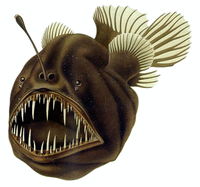
Photo from wikipedia
To obtain important baseline information about population dynamics and to provide valuable insights about the possible effects of artisanal fishing on the demersal fish community, this study had three specific… Click to show full abstract
To obtain important baseline information about population dynamics and to provide valuable insights about the possible effects of artisanal fishing on the demersal fish community, this study had three specific objectives: (1) to update the annotated list of demersal teleost species occurring in the Azores (mid-North Atlantic); (2) to describe their depth distribution and related fishery information; and (3) to evaluate annual changes in their observed abundance and length composition. To do this, a time series with about 25 years of scientific data from the commercial fishery and surveys was analyzed. The demersal teleost community was represented by 213 species, predominantly deep-water species, reflecting the main marine habitat in the Azores region. Fishery takes place mainly in the intermediate strata (200–600 m), where the most commercially important species occur. No changing in the fork length (LF) distribution toward small individuals caused by size-selective fishing was detected in this study. The high variability observed in the LF data indicates the need for more accurate studies considering alternative statistical analyses (e.g., generalised linear models) to examine the possible factors (e.g. depth coverage, gear configuration, soak time, and fishing area) that cause this variability. On the other hand, the abundance indices of some commercially important species appear to have declined (Phycis phycis, Pontinus kuhlii, Conger conger, Beryx splendens and B. decadactylus), while others appear to be more stable (Helicolenus dactylopterus) or even increasing (Mora moro). Although the available data are insufficient for a formal assessment on the status of exploited populations, the long-term analysis of commercial landings and survey data was used as a basis to assess deep sea demersal teleost fisheries of the Azores, under a precautionary approach.
Journal Title: Aquatic Living Resources
Year Published: 2019
Link to full text (if available)
Share on Social Media: Sign Up to like & get
recommendations!